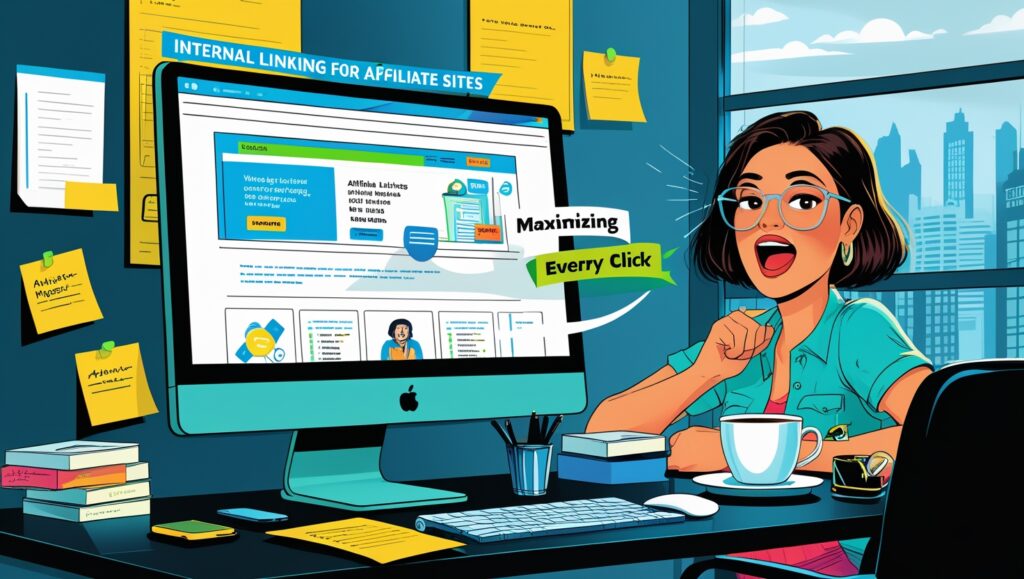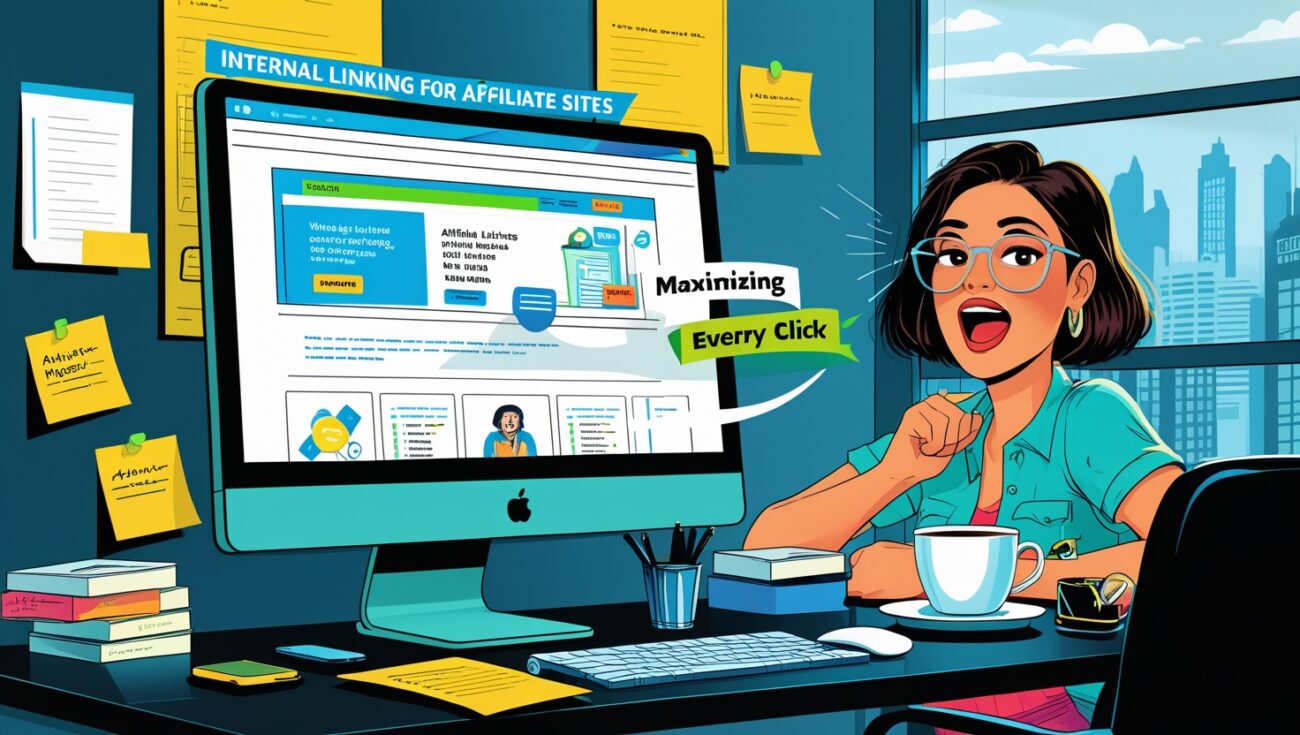Internal Linking for Affiliate Sites: Maximize Every Click
If you run an affiliate site, you know the grind. You spend countless hours creating content to rank in Google, and you watch the traffic roll in. But here’s the problem: traffic doesn’t pay the bills. Clicks on your affiliate links do.
I’ve been there, staring at my analytics, wondering why my top-ranking informational articles weren’t translating into commissions. It wasn’t until I started strategically using internal links that I finally connected the dots and turned my website into a powerful, revenue-generating machine.

Table of Contents
For affiliate marketers, internal linking isn’t just an SEO tactic; it’s the secret to maximizing every single click. It’s the strategy that guides your readers from a helpful “how-to” article all the way to a high-converting product review. This is how you bridge the gap between getting traffic and earning commissions.
The Funnel for Affiliate Sites: From Information to Conversion
Most affiliate sites have a simple funnel, but they often fail to connect the two most important parts:
- Top of Funnel (Information): These are your broad, high-volume search articles, like “what is a travel camera” or “how to start a blog.” They’re great for SEO and attracting a wide audience, but they are not designed to sell.
- Middle of Funnel (Conversion): These are your money-making pages, like “Best Travel Cameras for 2024” or “Bluehost vs. SiteGround Review.” These pages are designed to earn commissions.
The problem? Most bloggers leave a huge, invisible gap between these two types of pages.
The Core Strategies for Affiliate Internal Links
Strategy 1: The “Contextual Bridge”
Your informational articles are a fantastic source of traffic. Your review pages are what make you money. Your internal links are the bridge between them. When you write an article, always look for opportunities to link to a relevant review page.
Example: In an article titled “How to Start a Podcast,” you can add a sentence like, “The microphone you choose can make or break your sound quality. We’ve reviewed the top five microphones for beginners in our latest guide.” This is a clear, natural invitation to click.
Strategy 2: The “Hub-and-Spoke” for Affiliates
Think of your main comparison pages as your “hub.” For example, an article titled “Best Laptops for College Students” would be your hub. Then, every individual product review (e.g., “Review of the Dell XPS 15”) would be a “spoke” that links back to the hub. This creates a clear authority structure, helps the hub page rank for broad keywords, and guides users through a comprehensive buying journey.
Strategy 3: Rescuing Your High-Converting “Orphans”
A high-converting review page is useless if it has no internal links pointing to it. I was shocked to find that some of my best-written review pages were completely isolated from the rest of my site. I now know these are called orphaned pages. Your highest-converting pages deserve to be linked to from all of your high-traffic informational articles. I use a tool like Linkbot to easily find all of my orphaned pages, which is an absolute game-changer for my affiliate revenue.
Common Mistakes That Kill Affiliate Clicks
- Ignoring Anchor Text: Generic anchor text like “click here” or “learn more” provides no psychological incentive to click. Your anchor text should be descriptive and compelling, promising to solve a problem or provide more information.
- Not Linking to Relevant Content: A link from an article about “dog food” to a review of “car tires” is a pointless click. Your internal links must be contextually relevant and helpful to your reader.
The Role of Automation for Affiliate Success
Managing an affiliate site with hundreds of pages and thousands of potential internal links is impossible to do manually. You would have to constantly audit your content to find missed opportunities. This is where automation comes in. Automated internal linking software can analyze your website and provide a prioritized, actionable list of linking opportunities that will benefit both your SEO and your affiliate commissions. With Linkbot, you can take control of your internal linking and start turning more of your clicks into commissions.
Conclusion: Turn Clicks into Commissions
For affiliate sites, internal linking is the ultimate low-cost, high-impact strategy. It’s the glue that holds your content together, guiding your visitors from a helpful discovery all the way to a happy purchase. By creating a clear, intentional internal link structure, you’re not just improving your rankings; you’re actively building a more effective sales funnel.
Don’t let your valuable traffic go to waste. Start using these internal linking strategies to maximize every single click and watch your affiliate revenue grow. Ready to turn your clicks into commissions? Explore how Linkbot can simplify your affiliate internal linking today.
My journey taught me that a major mistake is thinking that my job as an affiliate marketer is just to write content. By using a revenue-driven approach to my internal linking, I was forced to think about how every piece of content contributed to my bottom line. This mental shift transformed my website from a collection of blog posts into a single, cohesive, and profitable ecosystem.
The long-term, compounding effect of this strategy is what makes it so powerful. Each time you add a thoughtful, relevant link from an informational article to a review page, you are making your entire website more authoritative and more effective at converting visitors. This is a foundational, evergreen tactic that continues to build momentum over time, ensuring your website becomes an increasingly powerful asset.
I’ll never forget the satisfaction of seeing a direct click-to-commission path in my analytics. It was a clear, undeniable line from a high-ranking blog post to a product review to an affiliate sale. This was my “aha” moment. I realized that my content wasn’t just getting me traffic; it was actively contributing to my revenue.
A well-planned internal link structure also has a huge impact on your website’s overall trustworthiness and authority. When a user or a search engine bot lands on your page and sees a clear network of interconnected, relevant articles, it signals that you are a serious, comprehensive resource on the topic. This kind of professional organization is exactly what Google looks for.
The most important part of this foundational skill is building a consistent habit of linking. It’s not about a single audit and then forgetting about it. A good affiliate site is a living thing, and it needs regular maintenance to ensure your internal links stay clean, which benefits both your SEO and your user experience.
I felt like I was finally in the driver’s seat of my affiliate business. For years, I had relied on external factors like social media and ad campaigns, which felt like I was giving up control of my revenue. But by mastering my internal links, I was proactively building my site’s authority and sales funnel from the inside out, on my own terms, which was an empowering and exciting feeling.
When a user can find what they’re looking for with ease and is never sent to a broken link, it reinforces a sense of professionalism and care. This positive user experience leads to more engagement and a higher likelihood of a click on an affiliate link. A clean, logical internal link profile directly builds trust with your visitors.
By implementing a strategy that serves both SEO and conversions, you are also directly addressing Google’s E-E-A-T framework. You are demonstrating expertise by creating topical clusters, you are showing authority by linking from strong pages, and you are providing a better user experience, which is a key part of what Google looks for in a trustworthy affiliate website.
I’ll never forget the first time I applied my new internal link strategy to a low-traffic, informational page that I thought was worthless. After I added a few strategic links to a high-converting review page, that low-traffic page started sending a consistent flow of clicks and, eventually, commissions. This personal experience proved to me that the work I had already done held incredible, untapped value, just waiting to be unlocked.
One of the greatest benefits I got from using an automated tool to manage my internal links was the “to-do” list it provided. Instead of being overwhelmed by the sheer size of my website, the tool gave me a prioritized, actionable list of connections to make. It transformed a monumental, frustrating task into a series of manageable steps that I could tackle in just minutes.
It’s also crucial to understand the difference between a simple list of reviews and a true “affiliate hub.” A simple list just groups products. A true hub, however, links to all relevant informational content on your site, which helps a user make a more informed decision and shows Google that you are a comprehensive resource on the topic.
Ultimately, internal linking for affiliate sites is the rare SEO tactic that doesn’t require a compromise. It is a powerful, low-cost strategy that improves your search engine rankings by building authority and makes your website a more effective sales tool by guiding your customers toward a purchase. It’s a win-win for everyone involved.

